admirable characters
by Glenn Roberts
Photography by Glenn Roberts
|

Benelli - Ducati - Garelli - Laverda - Moto Guzzi - Moto Morini - MV Agusta |
|
Welcome to our fourth installment of Admirable Characters.
This issue we take a look at a few of the motorcycles from Italy. Some of these machines consist of an engine bolted onto a regular bike frame like the early Garelli all the way to the more exotic race models like the technologically advanced red beauties from Ducati. |

|
|
Many factories throughout Europe stopped production of their products to re-tool and manufacture military equipment. Whatever transportation existed before the war was destroyed or worn out leaving a huge demand for inexpensive economical transportation. Engines of the day were not of large displacement but that served nicely to preserve fuel rations and small single cylinder engines were less to produce. In time, however, the Italian motorcycle industry found its own niche. Engines began to grow in size and many of the motorcycle manufacturers found great success in the world's racing arenas. Names like MV Agusta, Benelli and Ducati just to name a few became major race contenders. There were a large number of Italian motorcycle producers but many did not survive because of competition or fell on hard economic times and have just faded away. Most of the Italian motorcycle marquees that have survived are known for their beauty and prowess on and off the track. I hope you enjoy this installment of Admirable Characters. |

1973 Benelli Tornado 650cc Overhead cam four stroke twin.
|
Benelli: In 1911 three brothers opened a small workshop only to become one of Italy's most famous and oldest motorcycle marquees. The workshop initially did repairs to automobiles, motorcycles and oddly enough, firearms. Shortly after opening the shop the brothers began to produce parts for automobiles and aircraft for the war effort. After the war, the need for cheap and efficient transportation prompted Benelli to build small engines to be attached to regular bicycle frames. The engine was too powerful for most bikes frames to handle so the Benelli brothers designed their own frame to mount the engine becoming the first Benelli motorcycle. |
|
The company saw many years of racing victories but the late 1960's saw financial troubles for Benelli. The 650cc OHV Twin Tornado was just released when the company was taken over in 1971 by Argentinian industrialist, Alejandro de Tomaso, who also owned Moto Guzzi. The new ownership cut most lines of Benelli motorcycles but the Tornado survived. The company later went on to produce in-line 4 and 6 cylinder engines.
|

|
Ducati:
1965 Ducati Sebring
|
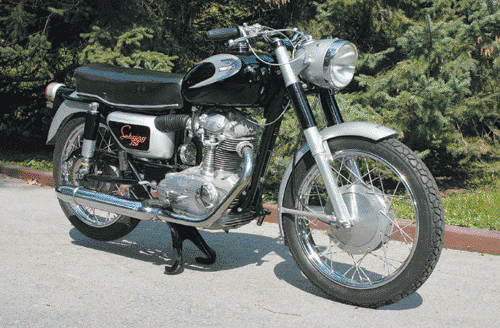
|
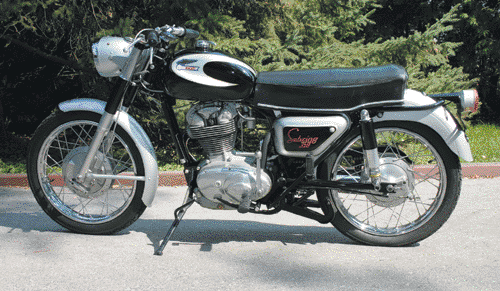
|
350cc Larger version of the sporting single.
Restored by Kevin Lalonde
|
|
1966 Ducati Monza

250cc The classic bevel drive four stroke single.
This bike is brand-new, with only 100 miles on it.
|
Ducati:
Adriano Ducati studied physics and was more interested in radios in his youth than mechanical machinery. He started an electrical equipment company in 1926 and soon expanded into optics and mechanics. The German Army commandeered the plant during the war and shipped the equipment back to Germany before heavy bombing destroyed the factory.
|
|
The company rebuilt in 1946 to produce the 'Cucciolo' (puppy), a small 48cc engine to be clipped onto a bicycle frame for cheap economical transportation that was desperately needed after the war in Europe. Ducati broke a 12 hour speed record in 1951 with the blistering speed of almost 42mph. Later this engine was to be mounted into a moped of Ducati's own design.
|
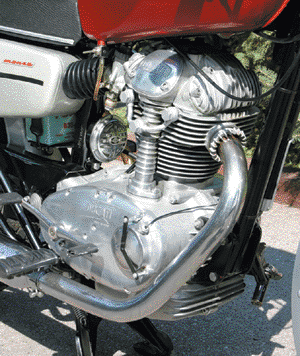
|
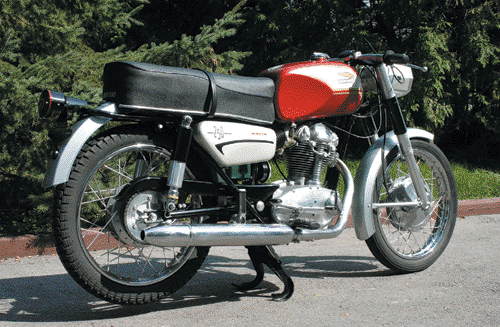
|
Engine development in 1950 resulted in a 60cc 4-stroke and their first true motorcycle. In 1954, Fabio Taglioni joined the company as chief designer and his first creation was the 'Marianna', a 98cc OHC 4-stroke single that filled the class leader board at the 1955 Giro d'Italia (Tour of Italy). |
|
1974 Ducati
GT750
750cc
|

|
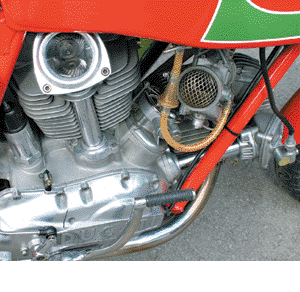
|
Customized 'Cafe' version of the early Bevel V-Twin four stroke
Built by Dan Swanwick
|

|
The last Giro was in 1957, the year Ducati filled the top 12 places with the Marianna's cousin, the Gran Sport. Part of the success was due to the dependability of Taglioni's bevel gear-driven camshaft which was expensive to build but allowed for consistently high speed operation. This design was to form the basis of many future Ducati engines.
|
|
1974 Ducati 750S
750cc
|
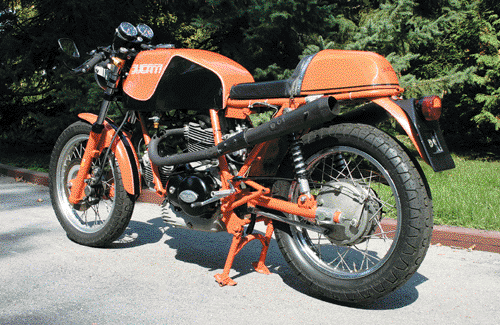
|
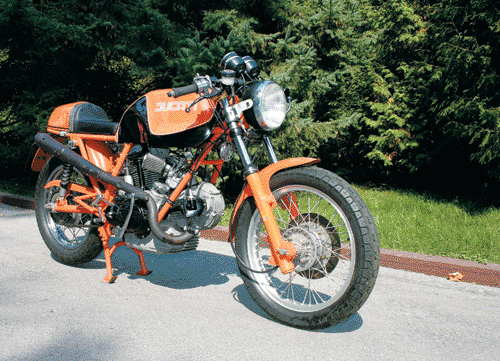
|
Customized 'Cafe' version of the early 750 Sport Bevel V-Twin four stroke
Built by Mike Jurgonlink
|
1977 Ducati 900SS
900cc
|
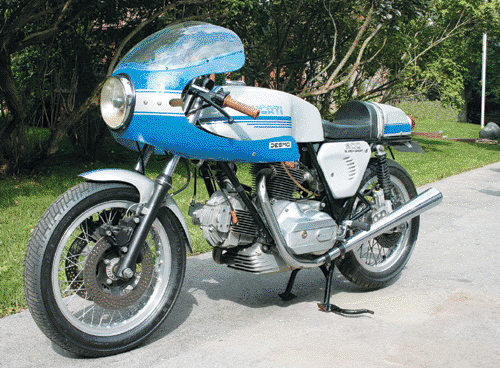
|
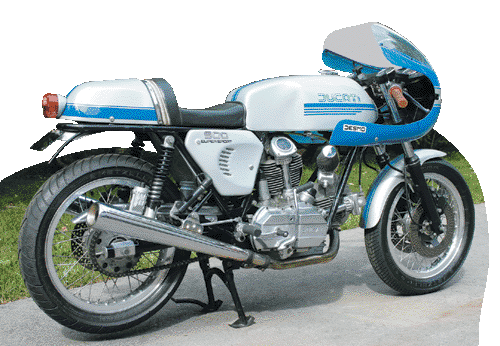
|
The first true Ducati Superbike, capable of 140 mph.
Restored by Peter McKenna
|
1983 Ducati
Pantah 500cc
Daytona Winning and Two time AMA Battle Of The Twins Champion-ship bike ridden by American Rogers Sears. Built in Canada by Tim Spiegelburg and Gary Wolf.
|
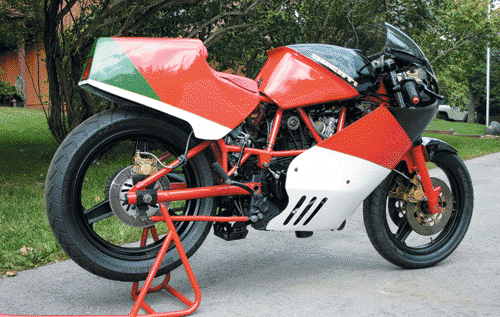
|
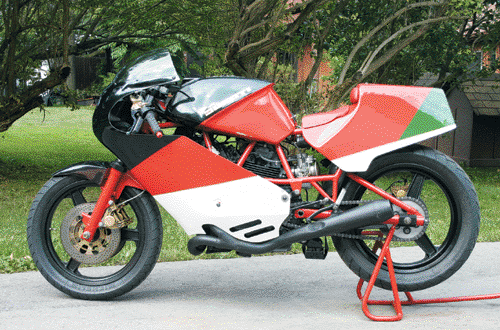
|
The mid-range parallel twins of the day never really caught on in Taglioni's mind. His answer was to have a mid-range V-twin. Enter the Pantah. The first time the expensive Bevel gear-driven camshaft was abandoned for a belt driven camshaft. The belt made for a quieter, simpler engine and much more economical to produce. The first prototype was built in 1977 but financial troubles persisted and the fact that the company was state owned delayed the release of the Pantah and it would not see the light of day until 1979.
|
|
1985 Ducati 'Hailwood Replica' 900cc
Later version of the Limited Edition Specials built to commemorate the great Mike Hailwood's legendary Isle Of Man TT win in 1978. This bike sports the Factory Race pipes.
|
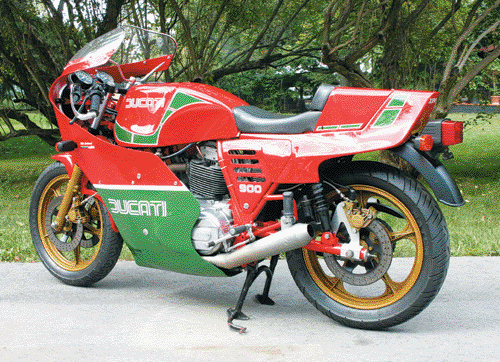
|
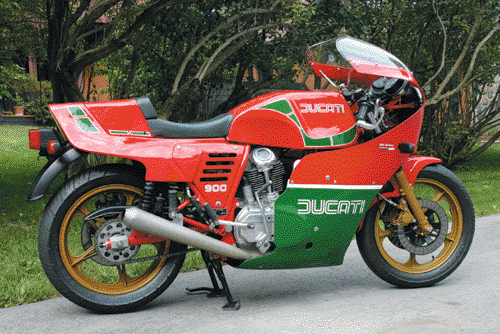
|
Ducati wanted to try its hand at GP racing but couldn't compete against MV, Mondial and Gilera in its present form. In 1956, The desmodromic system was designed, built and test in a few short months to come away with top honours at the Swedish Gran Prix by lapping every competitor on the track. Mike Hailwood won his first Gran Prix in 1957 on one of Taglioni's desmodromic 125cc singles.
|
| It was Taglioni's design of the desmodromic valve train that really put Ducati on the map. The desmodromic system eliminates valve 'float' by mechanically closing the valves resulting in higher RPM which in turn, means more power.
After Ducati's first bout of many financial troubles in the late 1950's, Ducati entered into production of their 250cc single which stayed in production for most of the 60's. Financial troubles reared its ugly head again in the late 1960's that resulted in the government stepping in to bail the company out which also meant the removal of some company executives to be replaced with government appointed officials.
Shortly after the financial rescue of the firm, Taglioni received the OK to design an 'L-shaped' 90º V-twin using the same bevel gear driven camshaft, a formula that was so successful in the previous singles.
|
|
1989 Ducati 851 SP1
851cc Liquid cooled,
Fuel injected
DOHC
Desmodromically operated
4-valve per cylinder
'L' twin engine.
|

|

|
The first limited edition 851 ‘Sport Production' bike. They were to form the basis of the World Superbike effort that would dominate racing for over a decade. Very rare, possibly the only one in North America. Obtained from Canadian Journalist George Jonas
|
|
The newly designed engine was released in the 750cc GT in 1971. Management tried to diversify by developing many models but this proved futile and the sales of the new models did not meet expectations, however, Mike Hailwood's comeback win on a Ducati in the 1978 Isle of Man TT did far more to help sales. Ducati once again faced financial troubles in 1983 and in 1985 Cagiva purchased Ducati. Many technical achievements were seen under the Cagiva ownership such as the four valves per cylinder, DOHC, liquid cooled and fuel injected Superbike.
|
|
1993 Ducati
888 SPO
888cc
|

|

|
The final version of the first Modern Ducati Sport Production 888 Superbike.
This bike is loaded with aftermarket carbon-fibre and tuning accessories
|
|
The first versions appeared in 1988 in the form of the 851 90º V-twin. In the 1990's, Ducati won 8 out of 10 World Superbike titles which helped Ducati reach record sales worldwide. The most important models in the 90's were Ducati's line-up of the SS series, the 851, 888, 916 and the 996 as well as the Monster range. |
|
1996 Ducati 955 SPA
955cc
|

|
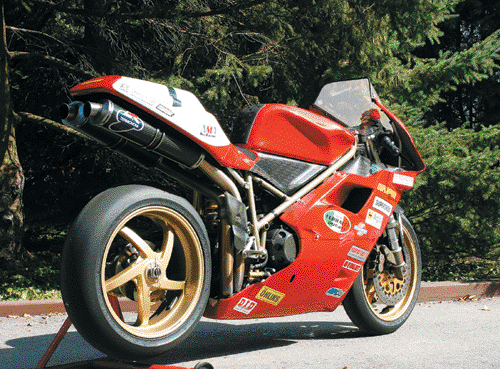
|
A rare variation of the legendary 916, only 50 of these SPA's were hand-built by the racing department to comply with AMA homologation rules in order to compete in the AMA Superbike series.
|
|
The top-of-the-line models were at the top of the performance charts comparable with the fastest motorcycles any other manufacture had to offer. Ducati became known as a technically advanced, state-of-the-art motorcycle that not only performs but also is one of the sexiest motorcycles on the road.
Finance troubles struck again in 1996 but an American investor group, Texas Pacific Group, rescued Ducati and the company became publicly traded in 1999.
|
|
1958 Garelli Mosquito
50cc Single cylinder two stroke moped
|
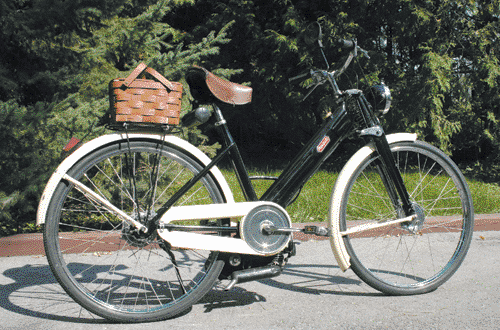
|
 |
Garelli:
At age 22, Adalberto Garelli received a degree in engineering and dedicated his work to developing and perfecting the 2-stroke engine for Fiat. Garelli quit in 1911 due to Fiat's lack of enthusiasm for the 2-stroke engine. He continued his own engine design between 1911 and 1914 which resulted in the 350cc split-single. Garelli worked for other motorcycle manufacturers from 1914 to 1918 during which time he won a competition organized by the Italian Army to design a motorcycle with which he used his 350cc split-single engine.
|
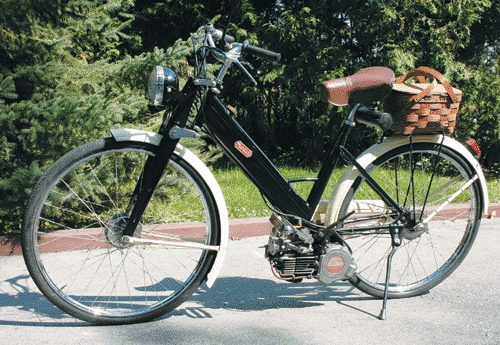
|
After WWI Garelli began to produce motorcycles in his own factory. The Garelli 350cc split-single stayed in production until 1926 and made a major impact in racing. By 1928 his motorcycle interest was waning and his factory began producing military equipment leaving motorcycle production completely.
|
|
1959 Garelli Mosquito
50cc Single cylinder two stroke with it's beautiful sculptured gas tank.
All original.
|

|
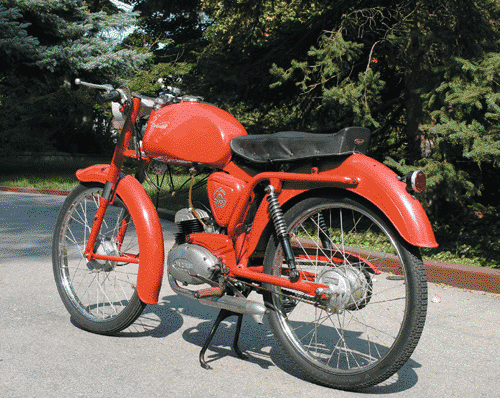
|
Demand for military equipment after WWII ceased entirely and Garelli once again appeared on the motorcycle scene, this time with an engine called the Mosquito. The Mosquito began as a clip-on engine for the regular pedal bicycle frame. The concept was a huge success over two million of the 50cc engines sold worldwide. Power was delivered to the back wheel via a friction wheel and was able to reach a top speed of 32kph (20mph).
|
Laverda:
The Laverda company can trace its roots back as far as 1873 to a farm machinery company owned by Pietro Laverda. In 1948, grandson Francesco Laverda built his own lightweight 75cc 4-stroke engine for personal use and amusement. Although he had no intention of building any more motorcycles, many of his friends asked him to build bikes for them so into production he went. By 1951, 500 bikes had been produced.
|

1972 Laverda 750SF
750cc Parallel twin four stroke, Overhead cam, Electric start.
|
|
In an attempt for national publicity, Laverda entered and won the first 14 places in its class in the 1953 Milano-Taranto long-distance road race. The following recognition led to an increase in displacement to 98cc. In the mid 1960's, Laverda was one of the early Italian motorcycle manufacterers to build large displacement motorcycles. The first of its famous parallel twins was an OHC 650cc engine. In 1967 the twin was increased in size to 750cc with great success once again in long distance endurance road racing. Laverda had many years of financial troubles and was eventually bought by Aprilia in 2000.
|

|
1972 Moto Guzzi Eldorado
850cc Transverse mounted push-rod V-twin. Shaft drive.
Aquired from Lang & Yvonne Hindle
|
Moto Guzzi:
Moto Guzzi was founded by Carlo Guzzi and Giorgio Parodi. There was a third man, Giovanni Ravelli, involved but he unfortunately was killed in a plane crash only days after WWI. The three motorcycle enthusiasts met and discussed plans to build a new motorcycle company while serving in the newly formed Italian Air Force. The flying eagle in the company's logo is in memory of Ravelli. The greatest of all Moto Guzzi models are based on only two engines. The first engine produced was a 500cc four stroke engine that had the cylinder parallel to the ground and the other engine was the 90º transverse V-twin. |
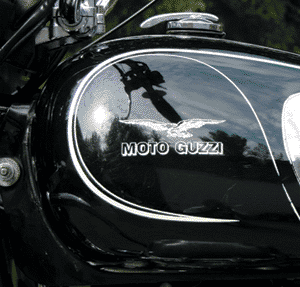
|
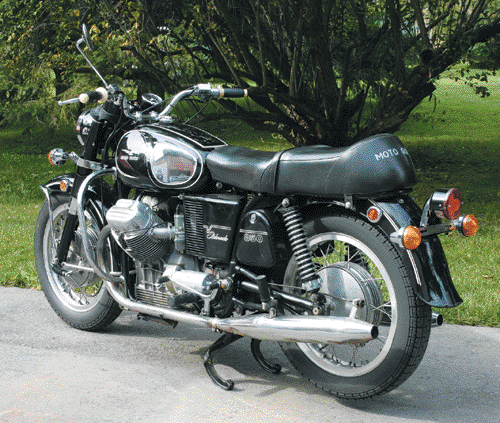
|
The single was in production since the initial prototype in 1920 and stayed in production until 1976 in various forms. The transverse V-twin came to exist to meet the requirements of a contract in the late 1950's with the Italian army who wanted a workhorse engine in a military vehicle with a single front wheel and double tracks on the rear. The engine did give way in later years to becoming a motorcycle engine, due in part because of military and police demands for more power after many years of using Moto Guzzi's single cylinder powered bikes. |

|
1986 Moto Morini Sport V
500cc Four stroke overhead valve V-twin with 'Heron' type cylinder head design.
|
Moto Morini:
Alfonso Morini, born in 1892, began producing a three wheeled truck in 1937. As many manufacturing plants did during WWII, Morini began producing military equipment. The factory was heavily damaged from Allied bombs but was one of the first factories to be rebuilt after the war ended.Morini died in 1969 and the company was left to Morini's daughter, Gabriella, to operate which she did until the company was taken over by Cagiva. The new owners let the name die a natural death as Cagiva concentrated their efforts on one of their other famous marquees, Ducati. The extremely efficient 500cc V-twin with 'Heron' heads (the piston crown forms the combustion chamber) was debuted in 1975 and proved to be a popular and durable engine. The same engine was also used in ISDT competition as well as production enduro machines which offered excellent performance in a dirt bike. |
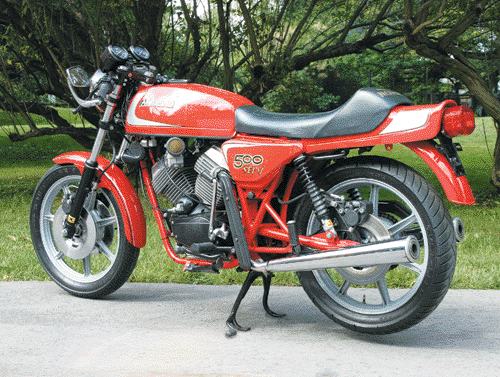
|
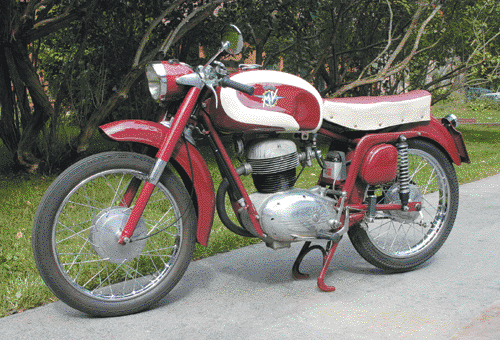
|
1960 MV Agusta
175cc Four stroke single |
MV Agusta:
The Agusta name has a long history in Italy for its production in the aviation industry and today is one of the world leaders in helicopter manufacture. Count Domenico Agusta inherited his fathers business in the late 1920's and considered motorcycling a keen hobby. In 1945 he produced his first motorcycle and the marque soon became known as the Ferrari of the two wheeled world.Inexpensive cars surfaced in the late 1950's that caused a number of motorcycle manufacturers to call it quits but luckily for Agusta he had the successful aviation business to fall back on. MV Agusta had enormous success in racing from the early 1950's to late 1970's and were ridden by some of the most famous racers winning 75 world championships, 270 Grand Prix wins and 3027 international race wins.
|
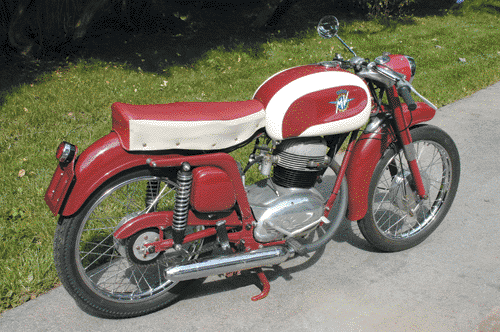
|
Originally published in Motorcycle Mojo Magazine, by author and photographer Glenn Roberts, reproduced here with kind permission. |

 Over the coming year we will be featuring an extensive photographic presentation of bikes from the Bar Hodgson Collection assembled by country of origin as originally published in Motorcycle Mojo Magazine, author and photographer Glenn Roberts, reproduced here with kind permission. This presentation of the fourth in the series features the Bikes of Italy originally published in the May/June 2005 issue of Motorcycle Mojo Magazine.
Over the coming year we will be featuring an extensive photographic presentation of bikes from the Bar Hodgson Collection assembled by country of origin as originally published in Motorcycle Mojo Magazine, author and photographer Glenn Roberts, reproduced here with kind permission. This presentation of the fourth in the series features the Bikes of Italy originally published in the May/June 2005 issue of Motorcycle Mojo Magazine. 




































